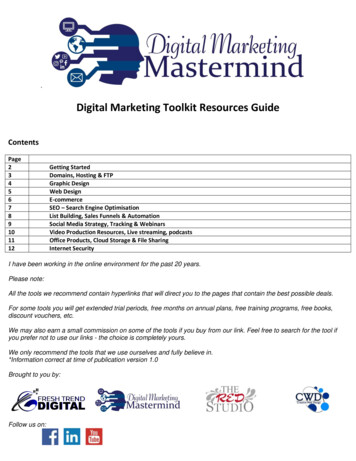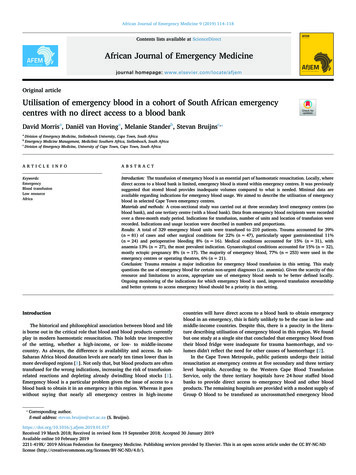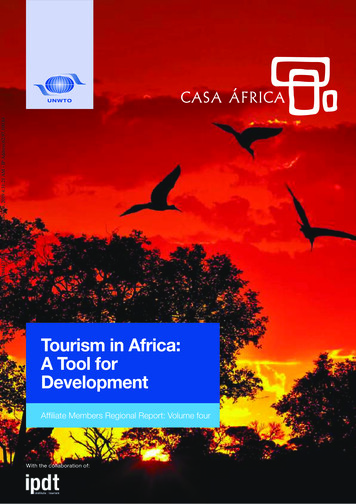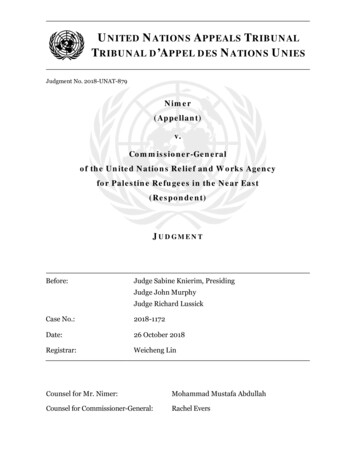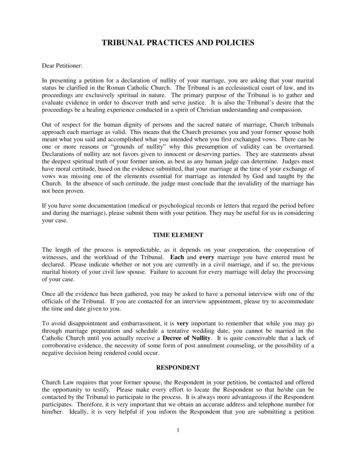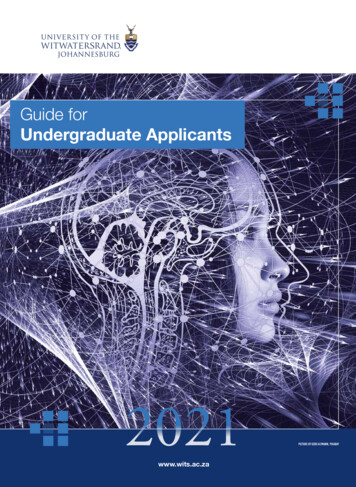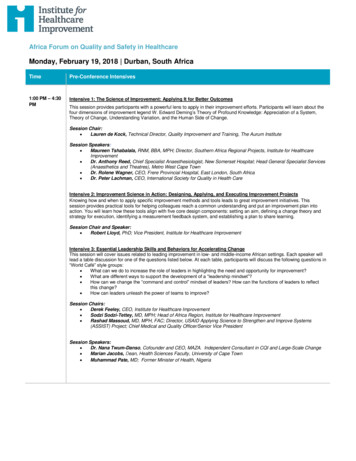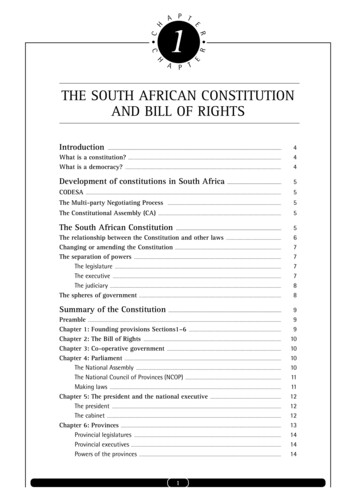
Transcription
COMPETITION TRIBUNAL OF SOUTH AFRICACase No: 74/LM/Sep11013235In the large merger between:Life Healthcare Group (Pty) LtdAcquiring FirmandJoint Medical Holdings LtdPanel:Heard on:Order issued on:Reasons issued on :Target FirmNorman Manoim (Presiding Member)Lawrence Reyburn (Tribunal Member)Medi Mokoena (Tribunal Member)21-29 May 201218 June 201224 July 201224 October 2012Non-Confidential DecisionINTRODUCTION[1] This is a merger of two hospital groups which impacts specifically on theDurban Central area. The Competition Commission (“Commission”) hadrecommended a prohibition of the proposed merger.[2] The factual and expert evidence in this merger was heard from 21-29 May2012 and the last day of closing arguments was 18 June 2012. The Tribunalissued its order on 24 July 2012 unconditionally approving the merger. Ourreasons for the approval are set out below.1
[3] During the hearing of this matter the Commission called the following factualwitnesses: Mr Niresh Bechan - hospital manager of the Ethekwini Hospital and HeartCentre Mr Glen Passmore - board director of the Hillcrest Private Hospital Dr Stan Moloabi – executive, healthcare management for GovernmentEmployees Medical Scheme ( GEMS) Mr Ebrahim Asmal - hospital manager of the Lenmed Shifa Hospital[4] Professor Alex Van Den Heever, a specialist in the South African healthcareindustry, and Mr Simon Pilsbury, an economist from Oxera, were called as theCommission’s expert witnesses.[5] The merging parties’ factual witnesses were: Mr Matthew Prior - funder manager at Life Healthcare Group Mr Kurt Wylie - board member of Life Healthcare Group Mr Jonathan Lowick - Group Strategy and Development Executive atLife Healthcare Group[6] Dr. Nicola Theron an economist from Econex, was called as the mergingparties’ expert witness.THE PARTIES TO THE TRANSACTION[7] The primary acquiring firm is the Life Healthcare Group (“Life” or “LHG”),1 awholly owned subsidiary of Life Healthcare Group Holdings. Life HealthcareGroup is a public company listed on the Johannesburg Stock Exchange andincorporated in terms of the laws of the Republic of South Africa.2[8] Life is not controlled by any single entity. Some of its main shareholders areOld Mutual Assurance Company South Africa (13.25%), GEPF corporated in the Republic of South Africa under Registration number: 2003/002733/06.2
(7.75%), CBNY: International Finance Corporation of South Africa (5.12%),Industrial Development Corporation of South Africa (5.02%) and MvelaphandaStrategic Investments (Pty) Ltd (3.25%).3[9] Life is currently one of the three largest private hospital groups in South Africaand has facilities which include hospitals, rehabilitation units, occupationalhealth clinics and facilities which care for chronically ill patients.4[10] Joint Medical Holdings (“JMH”), the primary target firm in this merger, ownsfive hospitals in and around the Durban area, namely; City Hospital, AscotPark, Maxwell Clinic, Isipingo Hospital and Durdoc Hospital.[11] Life currently holds a 49.4% shareholding in JMH. The remainingshareholders of JMH are individual medical practitioners or their family alpractitioners(collectively referred to as ‘doctor shareholders’) who in aggregate hold 50.6%of the issued share capital of JMH. JMH has approximately 306 doctorshareholders. None of these doctor shareholders individually holds more than6% of the shares.5THE TRANSACTION AND THE BACKGROUND[12] In terms of the present transaction, Life seeks to acquire a further 21% ofthe shares in JMH, thus increasing its shareholding in JMH from 49% to70%.6 Post merger, Life will not only assume a greater economic interest inJMH, but de jure control as well.3Commission’s Report dated 18 January 2012, page 7.Ibid.5Commission’s Core Bundle A File 1 page 43-44.6Jonathan Lowick explained during the hearing that the reason Life did not make an offer to go up to100% was that it believed in having its doctors as shareholders. Transcript 24 May 2012 page 104.43
THE RATIONALE FOR THE TRANSACTION[13] Jonathan Lowick, Life’s Group strategy director, stated that the proposedtransaction was in line with Life’s long-term strategy since it had a longstanding desire to own a majority of the shares in JMH.7[14] For JMH’s doctor shareholders the rationale is for them to realise all or partof their investment in JMH.[15] The more probable, though not expressly articulated reason, is that themerger resolves an impasse in the control situation of the hospital group aswe discuss more fully later.8 Lowick admitted during the hearing that acomplaint from a rival hospital network, the National Health Network(“NHN”), to the Competition Commission, alleging that Life was unlawfullynegotiating tariffs on behalf of JMH, had exacerbated the need to resolvethe control situation.9 Life, the de facto controller of JMH, will now, postmerger, become the de jure controller as well, whilst its economic interestincreases commensurately. This issue is discussed more fully later.RELEVANT MARKET[16] Unusually for a competition case, by the time it came to the hearing therewas no dispute about the relevant market. Despite some differences boththe Commission and the merging parties have accepted the marketdefinition as being the market for the provision of private hospital services inthe greater Durban Metro area.10 If one ignores the pre-mergershareholding that Life has in JMH, then the accretion in market share thatthe merger brings about would be as follows:7Transcript 24 May 2012, page 72.This is implied by the evidence of Lowick who described how Life had been struggling to acquire amajority stake since he had knowledge of the issue. This was from 2009.9See transcript page 102. The complaint was made in October 2010.10The area in which four of the JMH hospitals are located in Durban central also has two Lifehospitals, two Netcare hospitals and an independent in close proximity. See Exhibit A, a map of theGreater Durban area, indicating the location of several hospitals belonging to JMH, Life and othergroups. Asmal, of Lenmed Nushifa, one of the Commission’s witnesses, remarked in an email to afunder that hospitals in Durban were no more than a 5 kilometre radius from one another. See ExhibitG1.84
Market shares in Greater Durban marketFirmPre-merger market sharePost-merger market wini3.083.08Hilcrest7.977.97Nu Shifa6.486.48100.00100.00TotalThe post merger HHI would be 3566 representing an increase of 1072.11[17] On this basis the merger brings about an increase in Life’s market share of15.5% in the region; from 34.5% to just over 50%. Life of course has a preexisting holding of 49% in JMH and a degree of pre-existing control over it.Life argued that this pre-existing shareholding of 49% needs to be factoredinto the market share calculation on a proportional basis and if allowance ismade for this and the fact that it only intends to acquire up to 70% of theequity in the present transaction then its market share accretion in theGreater Durban market would be only 4.65% and its total shareholdingwould be 45.4%.[18] The Commission did not accept this approach to determining market shareincrements.12 We do not need to decide this issue in the present case. Theproper consideration is what is the relevant counterfactual because oncethis has been identified the proper competition consequences of the mergercan be more clearly identified.11The source for these figures is Table 3.2 in the Oxera report prepared by Simon Pilsbury, theCommission’s expert.12See comment of Pilsbury in the Oxera report, page 22, where he says he considers this an unusualand inappropriate approach to determining market shares.5
APPROACH[19] We will first decide the proper counterfactual. Having decided that we thengo on to consider the various theories of harm advanced by the Commissionand the merging parties’ response.THE COUNTERFACTUAL[20] In merger cases the assessment of the relevant counterfactual is anessential part of the analysis. Essentially this involves a comparison ofmarket outcomes; the market that would prevail without the merger, usuallytaken as the status quo, compared with the scenario that is likely to prevailpost-merger. The difference between the two scenarios informs the thresholdquestion raised by section 12A(1) of the Act viz. – whether the merger wouldlead to a substantial prevention or lessening of completion. Usually the statusquo serves as the proxy for what the market would be like absent the merger,while the post- merger future requires a predictive analysis.13[21] This has been the approach of the merging parties, who argued that Lifehad, since its acquisition of a 25% stake in JMH, in 1997, exercised de facto,albeit not de jure, control over JMH. Since de facto control suffices as a formof control in terms of section 12(2)(g) of the Competition Act, Act 89 of 1998(“the Act”), the only difference the merger makes is the establishment of dejure control.14 Since the merging parties argue that the move from de facto tode jure will have minimal impact on JMH’s behaviour for competitionpurposes, the merger essentially retains the pre-merger competitive statusquo.13See Mondi Limited and Kohler Cores and Tubes (Competition Appeal Court (CAC) Case Number20/ CAC/ June02) at paragraph 38, where the CAC held that the section whilst not permittingspeculation lacking an evidential basis nevertheless still,“. enjoins the Tribunal to make a predictivejudgement based on the evidence which has been placed before it.”14We set out the terms of this section in paragraph 30 below.“6
[22] The Commission’s approach is that the facts of this case constitute anexception to the normal approach that the status quo serves as the proxy forthe market without the merger. The reason it does so is that whilst Life maycontrol JMH presently in the same way as it might post merger, the questionis whether it does so lawfully. If it does not do so lawfully then the status quoshould not serve as a proxy for the market without the merger.15[23] In order to decide this we need to review the history of events leading up tothis merger as well as evidence on this aspect given in the course of thehearing.[24] In 1997 Life’s predecessor acquired a 25% interest in JMH.16 Theshareholders agreement concluded then is still operative. 17 As far as legalform goes, the agreement gives Life rights to appoint 25% of the directorsand to exercise a veto in relation to a number of key operational decisions inJMH. It does not give Life the right to control the board of directors or themajority of votes at an annual general meeting. Although Life acquired afurther stake in JMH in 2004, taking its holding to the present one of 49.4%,this did not lead to an alteration of the original shareholders agreement norto the control situation despite the fact that Life had almost doubled itsequity in the company. Whilst it was allowed in practice to appoint anotherdirector to the board, Life still did not bring its board representation in linewith its shareholding percentage. We are told that immediately prior to themerger Life appointed three directors to the JMH board of eight.18 As wediscuss below this further acquisition was not the subject of a merger filingunder the Act.15In the European Commission’s merger guidelines allowance is also made for situations where thepre-merger market counter factual is not the status quo, but also might require a predictive analysis,See Economics for Competition Lawyers, Gunnar Niels et al, Oxford University Press 2011, page338-339.16The predecessor was a company called Presmed which later became Afrox and then, after arestructuring of the shareholding in Afrox in 2005, became Life. Nothing turns on this change in nameas the company remained the same throughout and for that reason, to avoid confusion, we will simplyrefer to Life throughout although this appellation is not historically accurate for the period prior to2005.17Shareholders agreement, record File A pages 386-410.18See witness statement of Kurt Wylie paragraph 3.2.7
[25] Thus to summarise – immediately prior to the present merger Life did notcontrol the majority of votes at either board or general meeting levelalthough the shareholders agreement gave it rights of veto in certainspecified instances.[26] In the present merger, Life contended that despite the absence of de jurecontrol, it has de facto controlled JMH since 1997.[27] The witness put up by the merging parties to testify on this aspect wasKurt Wylie who wears two hats – he is both an executive of the LifeHealthcare Group and also served on the JMH board from 2006 to June2011 as one of Life’s nominees.19 He could not testify about the positionthat pertained earlier than this, but he could state that he was told that themanner in which things worked when he assumed his position on the JMHboard was no different from what had prevailed since 1997. Hence, hecontended, it was reasonable to assume that the manner in which Liferelated to JMH from 2006 onwards was no different to the position in theperiod from 1997 until 2006.[28] Wylie’s evidence was that Life controlled all the major decisions that JMHmade.20 Prior to board meetings agreements on the agenda items werereached between the doctor-appointed directors and Life’s executives. Life’sviews always prevailed. JMH has discovered all its board minutes for theperiod. Nothing has emerged from a perusal of these that was inconsistentwith Wylie’s version.21 This is not to say that there were not differences instrategy between the directors nominated by the doctor shareholders andthose of Life. Indeed one internal strategy document authored by Life19Wylie’s witness statement page 2.See Wylie witness statement paragraph 3. Similar evidence was also given by Matthew Prior, Life’sfunding manager. See Prior’s witness statement at paragraph 2.7 where he stated, “LHG is by far thelargest single shareholder in JMH and, in practice, controlled JMH from before the time thatnegotiations at a hospital and scheme/ administrator level commenced.”21The Commission did identify minutes where some matters of disagreement arose from time to timebetween doctor appointed directors and those nominated by Life. But nothing material arose from thisindicating that Life could not prevail over the other shareholders when the issue was importantenough to it.208
executives highlights these differences very clearly.22 But what the recordshows is that to the extent that differences existed, the views of Life alwaysprevailed.[29] The next event of importance that occurred was Life’s 2001 acquisition ofAmalgamated Hospitals Limited (“Amahosp”), a firm that managed andowned four hospitals in Kwa Zulu Natal. This merger, as required, wasnotified as a large merger in terms of the Act in July 2001. In terms of thenotification requirements an acquiring firm, in this case Life, is obliged to listall the firms it controls. If Wylie’s evidence is accepted then Life controlledJMH in 2001. But the Amahosp merger notification makes no mention of thisfact.23 In another part of the form, the notification describes JMH as acompetitor.24 Market shares of the firms in the greater Durban market aregiven and there again JMH is listed as a competitor. The only clue of anylink between the two hospital groups is the annual financial report of Afroxwhich, as required by the notification form, is annexed to the filing. In thereport there is a list of associated companies. Amongst those listed is JMH,together with a statement that the firm (then Afrox) holds 25% in what isdescribed as an associate.25[30] In terms of section 12(2)(g) of the Act a person controls a firm if thatperson- “ .(g) has the ability to materially influence the policy of a firm in amanner comparable to a person who, in ordinary commercial practice, canexercise an element of control referred to in paragraphs (a) to (f).”[31] On Wylie’s evidence JMH was controlled by Life by virtue of section12(2)(g) since 1997. This meant that JMH should have been reflected in theAmahosp filing as an ‘acquiring firm’, because in terms of the definitionsection of the Act, an acquiring firm includes all firms directly or indirectly22See Afrox position paper April 2004, Record File B1 1656.The record of the merger notification, dated 23 July 2001, is contained in Exhibit T1 submitted bythe Commission.24Ibid, page 7 paragraph 16.1. See also the competitiveness report which lists competitors and theirmarket shares. In this table JMH is listed as a competitor. See Annexure 2 to the merging partiesCompetitiveness Report.25See Ibid at Annual Report for Afrox Healthcare Group for year 2000 – page 57.239
controlled by another acquiring firm.26 Since Afrox then was an acquiringfirm and controlled JMH at the time, it should have been reflected as suchon the form CC4, which is the merger filing form. JMH was not reflected assuch and instead, as we noted, the contrary impression was created in thefiling that JMH was a competitor of the acquiring and target firms. alunconditionally. Mention is made in the reasons for the approval thatamongst the competitors of the merged firm in the market analysis wasJMH.27[32] In 2003 Life’s attorneys wrote to the Commission requesting an advisoryopinion. The attorneys wrote that Life sought to acquire a 49% stake inJMH. Their factual submission was that Life would not be able to controlJMH at board or general meeting level and asked if for that reason Life wasstill required to notify the transaction. In the attorneys’ view this was notrequired by the Act.28 The shareholders agreement entered into in 1997 wasnot, it appears, submitted to the Commission. The submission also does notmake mention of the fact that Life had had a 25% stake in JMH since 1997.But the most significant omission, if Wylie’s evidence in the present case iscorrect, is the failure to mention that at that time Life already de factocontrolled JMH. The reader of the letter would have reasonably assumedthat Life had no pre-existing stake in JMH and was preparing to acquire, exnihilo, 49%. What is more curious is that the same firm of attorneys hadnotified the 25% acquisition by Presmed (Life’s Predecessor) in 1997 to theCommission’s predecessor, the Competition Board.29[33] Despite this submission the Commission took the view that the stake couldlead to de facto control and advised Life to notify it.30 It did not do so, nor didit acquire the further 24% stake. Instead, almost a year later, a different firmof attorneys requested an advisory opinion on the subject from the26Section 1(1)(i).Tribunal Case Afrox Healthcare Limited and Amalgamated Hospitals Limited Case Number:53/LM/Sep01 paragraph 16 page 4.28See record Bundle A File 1 page 411.29See record Bundle A File 1 page 422.30See record Bundle A File 1 page 417.2710
Commission. This time the 25% stake was revealed as well as the existenceof the shareholders agreement. The argument now advanced was that thepre-existing stake had conferred a degree of control by way of the 1997shareholders agreement, but since that agreement would remain in placethe acquisition of the additional 24% would not change the quality of control.It was contended that Life exercised joint not sole, control over JMH.[34] After an initial objection the Commission was persuaded that this view wascorrect.31 In their letter the attorneys relied purely on an interpretation of theterms of the shareholders agreement. Whilst this was a fair reading of theshareholders agreement, no mention was made that the de facto situationwas that Life controlled JMH despite only holding 25% -- the view that Wyliehas propounded in this merger. After receiving the Commission’s opinionthat notification was not necessary Life proceeded to increase itsshareholding in JMH from 25% to 49%.[35] But there were further intervening events. In April 2004 the Commissionconcluded a consent order with the Hospital Association of South Africa(”HASA”) and its members, amongst which was Life. In terms of thatagreement HASA agreed to end centralised industry negotiations regardingthe setting of private hospital tariffs with the association that representedprivate healthcare funders.32 From then on each hospital or hospital grouphad to negotiate tariffs separately with each of the funders.[36] This meant that whilst JMH and Life had charged the same tariff up tillthen, being that of the industry as the outcome of centralised negotiations,they could not do so thereafter.[37] The evidence in this case is that in the period for which the witnesses couldprovide information Life has negotiated tariffs on behalf of JMH at all times31See record Bundle A File 1 page 416 for the initial objection, and page 474 for the subsequentacceptance.32See paragraph 7 of the HASA consent agreement 24/CR/Apr04. A similar consent agreement wasentered into with Board of Health Care Funders South Africa which negotiated on behalf of funders.See 07/CR/Feb05.11
except for the year 2003.33 The reason given for the exception in 2003 wasthat at that time Life held only 25% of JMH and JMH was not on Life’sfinancial systems. Certainly after Life had acquired the shareholding whichmoved its interest in JMH to 49%, Life negotiated tariffs on behalf of JMH.According to Lowick this was permissible notwithstanding the earlierconsent order undertakings because Life had interrogated its ownership ofJMH with the Commission and from this process Life had received comfortthat it could treat JMH as part of its network for the purposes of establishingtariffs.34[38] Asked specifically if the issue of negotiating tariffs on behalf of JMH hadbeen revealed to the Commission Lowick admitted it had not, but he wasnot able to explain the reason for the omission as he had not been in hiscurrent position at that time.35[39] The Commission argued that this was collusive. Life as a competitor ofJMH was not entitled to negotiate tariffs on its behalf. We deal with thiscontention later.[40] As we noted earlier, in the current merger Life argues that it has hadcontrol of JMH since 1997, including control over the setting of its tariffs,and hence the merger will have no affect on competition.[41] This position, as we have shown, is inconsistent with the stance that Lifetook towards the Commission in its Amahosp notification and in itscorrespondence when seeking an advisory opinion on two occasions in2003 regarding its contemplated acquisition of a further stake in JMH.33See evidence of Lowick at transcript 24 May 2012 page 84.Transcript 24 May 2012 page 85.35Transcript 24 May 2012 page 86. In a later answer he says that the advisory opinion from theCommission gave Life comfort that it could include JMH in its negotiations. See transcript page 91.3412
[42] This begs the question: which version of the facts regarding control iscorrect? We queried this with the merging parties during the hearing.36 Nowitness gave evidence which dispelled the apparent contradictions.37[43] In correspondence with the Tribunal the merging parties’ attorneys offeredan explanation.38 They properly concede that evidence previously submittedby the merging parties or by Life and relied on by the Commission andTribunal to the effect that JMH was a competitor of Life at the time, was notcorrect. They state that those responsible for the Amahosp notification areno longer employed by Life and that therefore they have to speculate as towhy the Amahosp merger was presented on the basis that it was. They goon to surmise that at the time of the Amahosp notification jurisprudencearound control was in its infancy and hence the extent of the concept wasnot as fully appreciated as it is now.39[44] For the purpose of this case we do not need to decide whether thisexplanation is credible. What we do have to decide for the purpose of thecounterfactual is which version of control is correct: the Amahosp filingversion in 2001, the version accompanying the second 2003 request for anadvisory opinion, or the version advanced in this merger. The choice isbetween no control of Life over JMH, (as implied by the Amahosp filing), anattenuated form of joint control (second advisory opinion letter in 2003) orunvarying sole de facto control (Wylie’s evidence in the present hearing).[45] On the evidence before us it would appear that the Wylie version is correct.The minutes trail, the document serving before the Life board to approve thedeal, are all consistent on this point.40 Wylie was thoroughly crossexamined on the control issue and in our view answered satisfactorily toissues within his personal knowledge.36Transcript 21 May 2012 page 3.Lowick when asked this says, “I think the focus is on the shareholder’s agreement and I don’t knowwhy.” Transcript 24 May 2012 page 92.38The present attorneys representing Life in this merger were not involved in either the Amahospnotification or the two applications for an advisory opinion referred to above.39See letter from merging parties attorneys to the Tribunal dated 12 June 2012.40See Record Bundle 1 File A page 360 Life Board paper July 2011 where it is stated, “Life has nowritten management contract with JMH, but decided on certain matters relating to the strategy ofJMH, particularly its business plan, budget, revenue, capital expenditure and operational costs.”3713
[46] We therefore find that Life or its predecessors have de facto had solecontrol of JMH since 1997. Whilst legally the doctor shareholders or theirnominated directors, acting jointly, may have been able to constrain thatcontrol, we have no evidence that they ever did so, certainly in any mannerthat might be competitively significant. The merger therefore serves to bringthe de jure situation in line with the de facto situation, as Life will now controla majority of the votes at board level and at general meetings.[47] Having made this finding we must answer the next key question whichaffects an important counterfactual question. If Life has controlled JMHsince 1997 will the merger make any difference to pricing behaviour postmerger since Life has controlled JMH’s pricing since 2003/4 when centralbargaining over hospital tariffs was outlawed?[48] Behind this question is an important principle of law.[49] Let us consider the position from first principles. It is a trite proposition thatif two competitors had colluded on pricing and then sought to merge theycould not rely on that prior collusion to argue that the merger would make nodifference to pricing post merger because the counterfactual is a market inwhich they did not compete. This would be contrary to a precept of publicpolicy that firms cannot benefit from their unlawful conduct.[50] The merging parties argue that their situation is not analogous to the oneoutlined above, as they had lawfully acquired joint control in 1997, and jointcontrol must pre-suppose joint pricing, otherwise control is stripped of itsessential meaning. However this argument ignores a key provision in ourlegislation which provides specifically for such situations and in a mannercontrary to that contended for by the merging parties.[51] The Act provides for a regime that discourages horizontal interests incompetitors. Whilst not making such holdings unlawful the Act creates a14
presumption, when consideration is given to horizontal restrictive practicesin which a combination of firms is involved, that an agreement existsbetween the firms where one of those firms holds a substantial interest inthe other or they have directors in common. 41[52] The intention of the Act is to facilitate the prosecution of firms in such asituation and thus to discourage such partial forms of control. But at thesame time the Act exempts from the provisions of section 4(1) agreementsbetween firms and their wholly owned subsidiaries.42 This exemption is alsoextended to firms that constitute part of a ‘single economic entity’.43 Theterm ‘single economic’ entity is not given precise definition. But the Act doesgive some guidance as it states that the exemption applies to theconstituent firms of a “single economic entity” that is “.similar in structure.”to entities in the wholly owned subsidiary –parent relationship.[53] The use of the word “similar” assumes that the subordinate or controlledfirm need not be wholly owned by the parent firm (otherwise subsection 5(b)would be redundant), but still seems to suggest that the structure is not farremoved from it. What is contemplated by the exemption is not merely firmsin a single economic entity. Its meaning is more limited than this since thereis an additional requirement that the relationship between the relevant firmsmust be “similar in structure” to the relationship between a parent companyand one or more wholly owned subsidiary or sub-subsidiary.[54] In U.S. law in terms of the so-called ‘Copperweld’ doctrine a firm is deemednot to be able to collude with itself.44 The boundaries of ‘self’ when located41Section 4(2) which states “ An agreement to engage in a restrictive horizontal practice referred tosub-section 1(b) is presumed to exist between two or more firms if –(a) any one of those firms owns a significant interest in the other, or they have at least onedirector or substantial shareholder in common; and(b) any combination of those firms engages in that restrictive horizontal practice.42Section 4(5)(a).43Section 4(5)(b).44Copperweld Corp. v Independence Tube Corp. 467 US 752, 104 Sct ( 1984).In Copperweld afirm and its wholly owned subsidiary were deemed incapable of conspiring with one another forpurposes of section 1 of the Sherman Act because they did not represent separate economicinterests. The application of Copperweld by the district courts in these latter cases has beeninconsis
the shares in JMH, thus increasing its shareholding in JMH from 49% to 70%. 6 Post merger, Life will not only assume a greater economic interest in JMH, but de jure control as well. 3 Commission's Report dated 18 January 2012, page 7. 4 Ibid . 5 Commission's Core Bundle A File 1 page 43-44.
